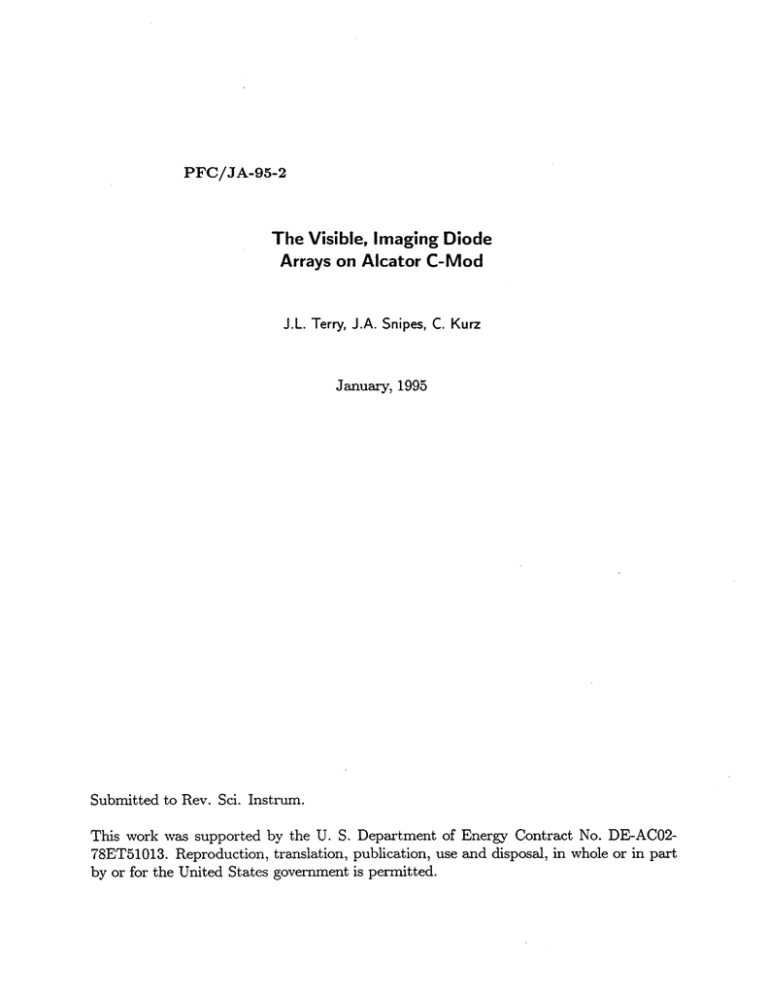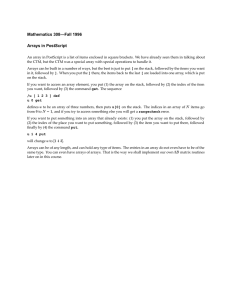The Imaging Diode Arrays on Alcator C-Mod Visible,
advertisement

PFC/JA-95-2
The Visible, Imaging Diode
Arrays on Alcator C-Mod
J.L. Terry, J.A. Snipes, C. Kurz
January, 1995
Submitted to Rev. Sci. Instrum.
This work was supported by the U. S. Department of Energy Contract No. DE-AC0278ET51013. Reproduction, translation, publication, use and disposal, in whole or in part
by or for the United States government is permitted.
The following will be published in Rev. Sci. Instrum. , Vol. 66, No. 1, January 1995
The Visible, Imaging Diode Arrays on Alcator C-Mod
J.L. Terry, J.A. Snipes, and C. Kurz
MIT Plasma Fusion Center
Cambridge, Massachusetts 02139
USA
Abstract
A set of multi-chord, absolutely calibrated viewing arrays has
been used to measure the distributions of H/D and C+ 2 emissions.
A total of 227 chordal views are available, with the chords
separated at the plasma by -1 cm typically. The chord brightness
profiles have been combined and inverted (without recourse to
symmetry assumptions) to yield local volume emission rates.
Because of the thickness of the superstructure surrounding
Alcator C-Mod, the views are from points re-entrant to the
vacuum vessel. All but one of the arrays employ 64-channel,
linear diode arrays, which are read out serially, thus requiring
only one digitizer channel per array. Variable frame rates (-1 Hz to
-3.5 kHz) result in an extremely large dynamic range for these
detectors. A 35-channel diode array which is read out in parallel
and can track fast events like ELMs or pellets is also in use.
Introduction
The lower temperature plasmas in the divertors and scrape-off
layers of present-day tokamaks are under intense investigation
due to the difficulty of achieving acceptable heat removal from a
burning, ITER plasma. It is advantageous for the temperature in
the divertor to be low, so that a significant fraction of the power
flowing into the scrape-off layer can be radiated before it is
conducted to the divertor plate, and so that sputtering thresholds
are not exceeded. Low divertor Te also allows for the existence of a
partially ionized plasma in which parallel ion momentum can be
absorbed 1 . The visible radiation from hydrogen and intrinsic or
1
seeded impurities, emitted under these conditions, can serve as a
valuable diagnostic 2,3 for this plasma. However, the emissions
from the divertor and scrape-off layer typically have complicated
spatial distributions. This is a result of the absence of poloidal
symmetry in the magnetic geometry ('dee' shaped cross-sections
and poloidal divertors) and the presence of localized plasma
phenomena (e.g. MARFEs, radiative divertors). On Alcator C-Mod
(which has both a shaped plasma cross-section and a poloidal
divertor) 4 a number of flexible, low-cost visible imaging systems
that view the plasma and internal vessel structures through
visible interference filters are in use. The purpose of these
spatially resolving arrays is to provide absolute brightness
measurements along many different chords which can be inverted
in a way such that local intensities can be determined.
Description of the Arrays and Their Views
One of the diode arrays, which views the discharge from
above, contains 35 elements, each 0.9x4.4 mm 2 in size. The signal
from each diode is amplified and digitized separately, and as such
differs only in its use of a lens and interference filter from the xray arrays which have been standard on fusion devices for many
years 5. The filter, lens, and array are placed behind the window at
the end of a re-entrant tube. The 35 chordal views are spaced
equally within the fan labeled 'Top Array #1' in Figure 1. The
entire field-of-view in a plane at the divertor is 0.47 m radially and
0.065 m toroidally. The parallel readout of this array allows
observation of fast events (up to 1MHz) like ELMs and pellet
ablation. It views the paths of the D 2 pellets injected into C-Mod.
The other visible arrays employ 64-channel Reticon 6 selfscanning, linear diode arrays. The desired sections of plasma are
imaged (through windows on re-entrant tubes) onto 8x10 mm,
coherent fiber bundles of lengths 1.8 or 4 m. The bundles have a
resolution of 50 line pairs/mm, but do not transmit usefully
below 400 nm, and are subject to transmission degradation if
exposed to neutron or gamma radiation. The images transmitted
by each bundle are viewed in two colors by employing a
2
beamsplitter in front of two SLR camera lenses. Following each of
these lenses is an interference filter and a lens which demagnifies
the image onto the diode array. Thus for each view, two visible
emission lines can be observed. The filters can be mounted in
wheels and selected remotely. The individual diode elements are
0.05 mm x 2.5 mm rectangles. This and the choices of plasmaviewing-lens, bundle size, and demagnifying lenses determine the
field-of-view in the plasma of each diode. Typically, for these
arrays, adjacent chords are separated by ~1 cm in the plasma. If
there is a significant toroidal curvature over the long dimension
of the rectangular diode elements (the "toroidal" dimension in
the plasma), then it should be masked to avoid loss of radial
resolution. (See 'Results-Brightness Profiles' section.)
Two primary advantages are gained with the use of these
devices. First, a very large dynamic range of measurable
brightnesses is achieved by varying the length of time the diodes
integrate the detected light (the frame time). Typical frame rates
ranged from 0.05 to 1 kHz, although rates from -1 Hz to -3.5 kHz
are possible. Independent of the integration time, the frame data
are read out in 680 ps typically, although this interval can be
reduced to 272ps. Brightnesses from -0.1 to -100 W/m 2 /ster have
been measured routinely. Second, the time histories of a large
number (64) of chordal brightnesses are acquired on a single
digitizer channel. The three different plasma views of these arrays
are shown in Figure 1 as 'Top Array #2' and 'Side Array #1' and
'#2'.
All of the arrays in combination provide nearly full coverage
of Alcator C-Mod's poloidal cross-section, missing only those
regions shadowed by the dosed divertor structures. The views are
not all in the same toroidal section. 'Top Array #1' is displaced
toroidally from 'Side Array #1' and 'Top Array #2' by 360, and
'Side Array #2' is displaced an additional 1080. Thus the composite
picture constructed from these views assumes toroidal symmetry
in the emission.
Calibration of the Arrays
3
In order to use all the arrays in combination, the absolute
sensitivity of each diode in each array (including all of the
imaging optics) was measured. In addition, the view of each diode
was determined. This was done in three steps.
First, the optical axis of each chordal view was measured
relative to the C-Mod vacuum vessel. (In most cases this was done
by moving a light source to known positions inside the vacuum
vessel.) Second, the relative sensitivity of each view within a
given array was calibrated. Although the responses of the diodes
are quite uniform, the imposition of the imaging optics resulted
in nonuniformities. It is also extremely desirable that the relative
sensitivity for a given array be independent of the interference
filter in front of it. To meet this condition, the filter bandpasses
were made >2.5 nm (FWHM), so that the ±60 spread in the rays
incident on the filter had a negligible effect on the transmission.
Relative calibration was accomplished by moving a low pressure,
H 2 lamp across the array field-of-view (with the array's Ha/Da
filter in place), and by making sure that the lamp image overfilled
each individual diode. The independence of the relative
calibration to the central wavelength of the filter was verified by
doing the same with a He lamp and the array's HeI filter (Xo=588
nm). Finally, the absolute sensitivity of a given diode's view
within each array was measured using an absolutely calibrated
tungsten ribbon lamp. Our estimate of the uncertainty in the
absolute angular position of the arrays is -10, while the
uncertainty in the diode-to-diode sensitivity within an array is ±
10% and the uncertainty of the sensitivities among arrays is +
20%.
Results - Brightness Profiles
In the tokamak environment the arrays have operated with
low noise and no detectable RF pickup from the ICRF auxiliary
heating (up to 1 MW of RF power). The accuracy of the
calibrations is best illustrated by constructing profiles generated by
arrays which have chords covering the same poloidal regions, but
which are displaced toroidally. Such a profile of Da emission,
4
using radially inward views, is shown in Figure 2a. The profile is
constructed from Side Array #1 and #2 (separated toroidally by
1080), and, along the common poloidal chords, the agreement in
brightness is quite good. In Figure 2b is shown a radial profile of
D a emission, as seen from above, looking through the main
plasma and into the divertor (Top Array #1 and #2, separated by
360 toroidally). The measured brightnesses over the common
poloidal region agree only over part of the profile. Further
investigation has revealed that the disagreement is a result of the
wide toroidal field-of-view of Top Array #2. For these
measurements, the array was used with its full toroidal view, and
the field-of-view at the divertor of each of its diodes was an 80 cm
(along a line tangent to a toroidal arc) x 1.6 cm (radial) rectangle,
compared to a 6.5 x 1.33 cm 2 rectangle for a diode of Top Array #1.
Thus the bright, radially narrow band of emission, seen by Array
#1 at Rmaj =0.68 m, will curve over and be averaged by almost 8 of
the Top Array #2 diodes. This effect is seen in the Top #2 data, and
since this limits the radial resolution, the "toroidal" field-of-view
of this array has been reduced for future experiments.
Results - Local Emissivities
The measurements of the Side Arrays and the Top Array #1
have been combined and inverted without recourse to symmetry
assumptions to yield local volume emission rates by a procedure
described by Kurz, et al. 7 An example of a measured distribution
of Da emission is shown as Figure 1 of that reference.
Measurements of C+2 (X~465 nm) emission have also been made.
For C+2, data from only the Top Array #2 and the Side Array #1
are available from the last Alcator C-Mod run period. By choosing
a time when the radial emission bands were less prominent (than
in Fig. 2b for example), the chordal measurements have been
inverted with the understanding that some of the radial structure
will be washed out by the too-large field-of-view of Top Array #2.
The result of such an inversion is shown in Figure 3. As expected
for the diverted C-Mod discharges, the Da and C+2 emissions are
asymmetric poloidally and concentrated around the divertor.
5
Accurate measurement of these and similar emission structures
was the goal of the configuration of the arrays and the inversion
technique. These local emission rates allow determination of
spatially resolved ionization rates and particle confinement times
for H [ref. 2]., and are being used to determine local influxes of C+2
[ref. 81.
Acknowledgement
This work was supported by U.S. DOE Contract No. DE-AC0278ET51013.
References
1 P.C. Stangeby, Nucl. Fus. 33,1695 (1994).
2 L.C. Johnson, E. Hinnov, J. Quant. Spectrosc. Radiative Transfer 13, 333 (1973).
3 W.L. Rowan, C.C. Klepper, C.P. Ritz, R.D. Bengston, et al., Nucl. Fus. 27,1105
(1987).
4 I.H. Hutchinson, R. Boivin, F. Bombarda. P.Bonoli, et al., Physics of Plasmas 1,
1511 (1994)
5 S. Von Goeler, W. Stodiek and N. Sautoff, PRL 33, 1201 (1974).
6 Product sold by EG & G Reticon, Salem, MA 01970
7 C. Kurz, J.L. Terry, J.A. Snipes, "Determination of Ha Enissivities from LineIntegrated Brightness Measurements on Alcator C-Mod", Rev. Sci. Instrum., these
proceedings.
8 C. Kurz, B. Lipschultz, G. McCracken, M. Graf, et al., Proc. 11th International
Conf. in Plasma Surface Interactions, Mito, Japan (1994), J. Nucl. Mater., to be
published.
6
Figure Captions
Figure 1. The cross-section of the C-Mod vacuum vessel,
including the fields-of-view of the 4 visible arrays. Some of the
views are displaced toroidally.
Figure 2. (a) The Da chord brightness profile constructed from the
two arrays which view the discharge from the side. The chord at a
height of -0.48 m views the inner nose of the divertor (the line
labeled 'a'). (b) The Da chord brightness profile constructed from
the two arrays which view the discharge from above. The chord
intersecting a midplane major radius at 0.621 m views the inner
nose of the divertor (the line labeled 'P'), while the chord
intersecting at 0.684 m views the outer nose (the line labeled 'y').
There are 60 chordal measurements from each of the side arrays
and Top Array #2. There are 35 chordal measurements from Top
Array #1.
Figure 3. The profile of C+2 (X-465 nm) emission 0.25 s after
plasma initiation. The plasma has just become diverted at this
time. Also shown are the grid of 5x5 cm 2 pixels used for the
inversion, the separatrix, and the gray scale for the emission rate
(at left). Although there is only one value of emission per pixel,
the inverted data have been smoothed, leading to the appearance
of structure finer than the grid.
7
Vacuum Vessel
Side
Array
#2
Array
Top
#2
Side
Array
#1
Closed
Divertor
Figure 1
8
50
i
chord
which I
Side Array
views
40
#1
Side Array #2.
----------
inner
div.
nose
E 30
U)
c
-
20
-
m
10
0
-0.8
-0.6
-0.4
-0.2
0.0
0.2
height of chordal view at inner wall (M)
0.4
Figure 2(a)
30
E
ITT!
j
II!!!
chord
which
views
inner
-
20
Ti
jITPrTfrT
I~!
*TTTTTTTI
chord
which
views
outer
div.
nose
div.
nose
Top Array #1Top Array #21
CO
Q)
C
10
/\/\I
-
-
-
m
0
0.50
i
.!
0.60
major
1
. .. . . . .. .I
!
0.70
0.80
0.90
I
1.00
of chordal view in midplane (M)
Figure
9
2 (b)
i
i
i i
A i
1.10
W/m 3
0.6-
300
0.4 - -*-
0.2
200
0.0-
-0.2-
100
-0.4-
-
-0.6
I
I
0.5
0.6
I
0.7
I
0.8
10
0
I|
0.9
1.0
Figure 3







